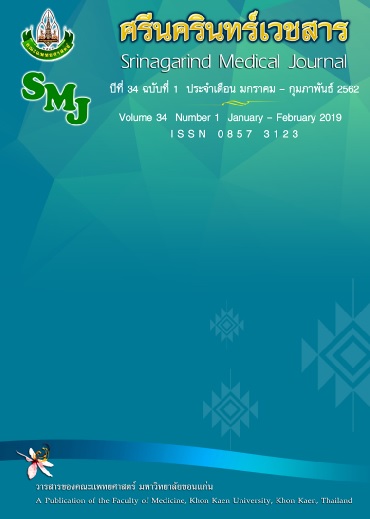The Outcome of Percutaneous Fixation of Transscaphoid Perilunate Fracture-Dislocation: A Series of 10 Cases
Keywords:
Transscaphoid perilunate fracture-dislocation; Percutaneous fixationAbstract
Objective: To study the short-term outcomes of transscaphoid perilunate fracture-dislocation treated with percutaneous fixation with headless compression screw and Kirschner wires.
Material and Method: A retrospective study of 10 transscaphoid perilunate fracture-dislocation patients who were treated at Khon Kaen hospital between July 2016 – December 2017. All of them, initially were treated with closed reduction of lunocapitate joint, and then underwent surgery with percutaneous fixation of scaphoid fracture and perilunate joints. The outcomes were measured using Mayo Wrist Score and radiographic parameters (scapholunate angle, lunocapitate angle, scapholunate gap and modified carpal height ratios).
Results: Ten patients were recruited in this study. Eight patients were male, and the average age of patients were 29 ± 7.84 years. According to Herzberg’s classification, there were type I in 7 patients, type IIa in 2 patients and type IIb in 1 patient. The scaphoid fracture configurations were all waist (two patients had comminution pattern). The total wrist arc of motion and grip strength averaged 76.26 ± 4.42 and 77.04 ± 1.01, respectively, compared with the contralateral wrist. The Mayo Wrist Score averaged 74.5 ± 8.64 points, classified as 1 excellent, 3 good, 5 fair and 1 poor. The patients that were operated within 10 days and after 10 days had Mayo Wrist Score averaged 81 ± 5.47 and 68 ± 5.7, respectively. Average scapholunate gap, lunocapitate angle and modified carpal height ratio were within normal limits of 1.33 ± 0.16 mm, 13.23 ± 5.8 degrees and 1.51 ± 0.06, respectively, but scapholunate angle was relatively high with an average of 58.16 ± 5.62 degrees.
Conclusion: The treatment of transscaphoid perilunate fracture-dislocation with percutaneous fixation technique has acceptable short-term outcomes.
References
2. Scalcione LR, Gimber LH, Ho AM, Johnston SS, Sheppard JE, Taljanovic MS. Spectrum of carpal dislocations and fracture-dislocations: imaging and management. AJR Am J Roentgenol 2014; 203: 541–50.
3. Dobyns JH, Linscheid RL. A short history of the wrist joint. Hand Clin 1997; 13: 1–12.
4. Muppavarapu RC, Capo JT. Perilunate dislocations and fracture-dislocations. Hand Clin 2015; 31: 399–408.
5. Trumble T, Verheyden J. Treatment of isolated perilunate and lunate dislocations with combined dorsal and volar approach and intraosseous cerclage wire. J Hand Surg Am 2004; 29: 412–7.
6. Weil WM, Slade JF 3rd, Trumble TE. Open and arthroscopic treatment of perilunate injuries. Clin Orthop Relat Res 2006; 445: 120–32.
7. Yin Y, Gilula LA. Imaging of the symptomatic wrist. In: Watson HK, Weinzeig J, editors. The Wrist. Philadelphia: Lippincott Williams & Wilkins, 2001: 61-82.
8. Linscheid RL CW. Difficult wrist fractures. Perilunate fracture-dislocations of the wrist. Clin Orthop Relat Res 1987; 214: 136–47.
9. Gupta RK KK. Functional outcome after surgical treatment of perilunate injuries: A series of 12 cases. J Clin Orthop Trauma 2016; 7: 7–11.
10. Komurcu M, Kurklu M, Ozturan KE, Mahirogullari M, Basbozkurt M. Early and delayed treatment of dorsal transscaphoid perilunate fracture-dislocations. J Orthop Trauma 2008; 22: 535–40.
11. Chou YC, Hsu YH, Cheng CY, Wu CC. Percutaneous screw and axial Kirschner wire fixation for acute transscaphoid perilunate fracture dislocation. J Hand Surg Am 2012; 37: 715–20.
12. Forli A, Courvoisier A, Wimsey S, Corcella D, Moutet F. Perilunate dislocations and transscaphoid perilunate fracture-dislocations: a retrospective study with minimum ten-year follow-up. J Hand Surg Am 2010; 35: 62–8.
13. Hildebrand KA, Ross DC, Patterson SD. Dorsal perilunate dislocations and fracture-dislocations: questionnaire, clinical, and radiographic evaluation. J Hand Surg Am 2000; 5: 1069–79.
14. Kara A, Celik H, Seker A, Kilinc E, Camur S, Uzun M. Surgical treatment of dorsal perilunate fracture-dislocations and prognostic factors. Int J Surg 2015; 24: 57–63.
15. Oh WT, Choi YR, Koh IH, LIm KH. Comparative outcome analysis of arthroscopic-assisted versus open reduction and fixation of trans-scaphoid perilunate fracture dislocations. Arthroscopy 2017; 33: 92–100.
16. Kim JP, Lee JS, Park MJ. Arthroscopic reduction and percutaneous fixation of perilunate-dislocations and fracture-dislocations. Arthroscopy 2015; 4: 81–7.




